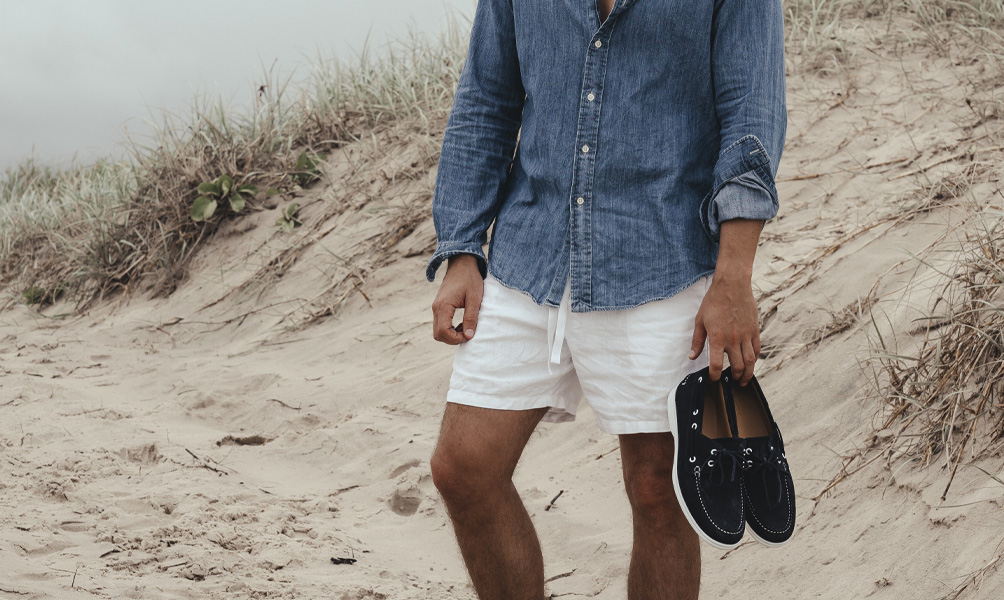20 Feb 2022
Difference Between Loafers, Boat Shoes & Driving Shoes
If you’re dipping your toe into men’s shoes for the first time, it can be a little overwhelming. All those Oxfords and Brogues and Derbies and moccasins and loafers, the ‘vamps’ and the ‘welts’, the different kinds of leather. We haven’t even put on pants yet and already there are 72 different options.
One confusing category that pops up all the time is men’s casual leather shoes, specifically the different between loafers, boat shoes and driving shoes. At the end of the day, you should wear what you like and what you find comfortable – that’s the golden rule. Who cares about the technical specs. But if you’d like to learn a bit more about these three key styles, and how to wear them, well this article’s for you.
What are loafers?
Men’s loafers hark back all the way to the 1930s, and they’re arguably the most flexible shoe going around. Loafers have a broad, flat heel and no laces or buckles. They’re designed to easily slip on and off your feet. In terms of fanciness, they sit somewhere between a lace-up dress shoe (like an Oxford) and a leather driving shoe, but to be honest, loafers are such a broad, versatile category that you can almost wear them anywhere. Black or brown, leather soles or rubber soles, tassels or no tassels; there’s a loafer for every guy and every occasion.
What are boat shoes?
Boat shoes are a cousin of the men’s loafer, but with one big difference: laces. Boat shoes, also known as deck shoes, top-siders or sailor shoes, often have 360-degree laces, where the laces actually thread around the heel of the shoe. These guys also come from the 1930s, and were originally designed to help sailors grip a ship’s deck. That’s why most boat shoes feature stitched rubber soles and an oil-treater leather upper. You can find boat shoes in natural leather, suede and Nubuck, and in every colour of the rainbow. They’re a versatile, smart casual summer shoe.
What are driving shoes?
Don’t let the name mislead you: driving shoes are great for driving, but the Italian sports car is definitely optional. These guys might have been developed in the 1960s to give rich European guys better grip on their pedals, but they’ve evolved over the years into a classic men’s casual shoe. A distant cousin of the loafer, driving shoes usually don’t have laces. They slip on and slip off with ease. What sets them apart is their grippy, trademark rubber-grommet sole (which usually wraps all the way up the back of the heal). You might hear these guys described as moccasins – that usually means the same thing.
Lacing options
If you’re after laces in this category, then boat shoes are the way to go. Loafers and driving shoes (or moccasins) are famous for their lack of laces. All these shoes technically count as slip-ons. In other words, you don’t usually need to lace and unlace your boat shoes – they should be a snug fit, but loose enough to kick on or off. If you’re after a loafer with a bit more detail on the upper, try tasselled loafers like the ALBERTO. These guys work well with cuffed chinos and a linen shirt.
Different materials
When it comes to materials, go with your gut. You can find boat shoes, driving shoes and loafers in premium leather, suede or Nubuck. In fact, boat shoes and driving shoes in particular really lend themselves to texture. Something like the MONTELLO or COUNTY would match perfectly with cotton shorts and a short-sleeve button up shirt. Loafers are much more likely to come in patent or premium leather, but there are some great suede options, like the GIANNI. These tend to work better with suiting separates or smart-casual outfits: try navy suede loafers with bone dress chinos, a sky blue shirt and knit blazer combo.
When to wear boat shoes vs loafers
This really comes down to texture (suede is less formal than patent leather, for example), but there are some hard-and-fast-rules, too. Boat shoes and suits are not on. Don’t even go there. Suede loafers are the dressier cousin of the boat shoe, and can be worn to cocktail events, bars, and anywhere that says ‘smart casual’ or ‘semi formal’ on the invitation. Boat shoes are pretty much casual-only wear, although you could probably get away with MANLY boat shoes for summer garden parties. Just pair them with chino shorts, leather belt and a floral button-up shirt.
When to wear loafers vs driving shoes
Driving shoes, like boat shoes, should really only be worn casually. ‘Smart casual’ at a stretch. They’re at their best on weekend roadtrips, pub lunches or running down to the shops. They’re still a smart shoe, smarter than a sneaker for example, but they’ll never fill the same role as a good dress loafer. Speaking of dress loafers, anything in premium or patent leather can go all the way from ‘smart casual’ up to ‘formal’. Patent leather black tassel loafers, like the ALBERTO, can even match with black tie. It’s what makes the loafer such a ridiculously versatile shoe.
When to wear boat shoes vs driving shoes
Anywhere you can wear boat shoes, you can also wear driving shoes. And vice versa. They fill the same broad footwear category: casual leather slip-on. Boat shoes have a slightly more coastal vibe, while driving shoes tend to be better for roadtrips (the stitched rubber sole and comfy flex really helps on long drives). Both shoes style quite similarly, too. They work best with high-cuffed chinos or cotton shorts. Jeans can work, but they need to be slim-fit with a neat double or pin-roll cuff. You want to flash a little ankle. (Check out our cuffing guide over here for more information).
How to style loafers
We’ve already written a whole loafer style guide, but here are the basics. Styling a men’s loafer really depends on the occasion and context. Slim-fit selvedge denim with a sharp cuff and classic brown loafers is a no-brainer smart casual look, and black penny loafers under a business suit can really mix things up around the office. Loafers also match well with cotton chino shorts: just pair some navy shorts with suede loafers or tan tassel loafers and throw on a linen shirt. When it comes to loafers and socks, you definitely want an invisible ankle sock, unless you’re attending a formal event (in which case some simple black dress socks should be fine).
How to style boat shoes
You don’t necessary need a boat to wear boat shoes, but with their nautical vibe they do lend themselves to lazy seaside afternoons. First things first, ditch the socks – or at least wear invisible ankle socks. For a clean summer look, match some navy boat shoes with cotton shorts or high-cuffed chinos and a simple button-up shirt. If you’re looking for a business casual ensemble, try brown leather boat shoes with dress chinos, a matching leather belt and knit blazer. Boat shoes tend to look best with light layers, textured fabrics (linen is a classic combo) and minimal styling. We’ve written a dedicated topsiders styling guide over here.
How to style driving shoes
Shorts and cuffed pants are the go here. Slim-fit jeans with no socks and a loose, crew neck tee also work brilliantly with driving shoes. They’re great for long-haul flights, barbecues, smart casual offices or al fresco dinners. Just keep a couple of rules in mind. Like loafers and boat shoes, you want no socks or invisible socks. Avoid pants that are too baggy or too tight – that means no bootcut or skinny jeans. And as the name suggests, driving shoes make a very practical, comfy and stylish choice for long car trips: the grommet soles really do grip the pedals better, and you can slip them off easily when you get to the beach.

.png.png?timestamp=2025-12-28T00:00:00+00:00)
